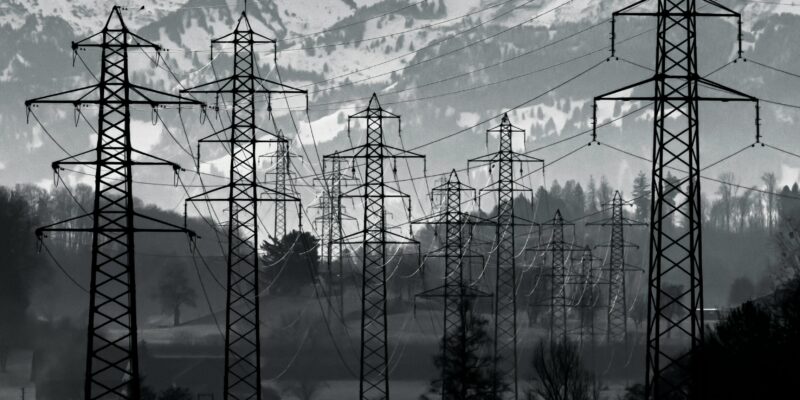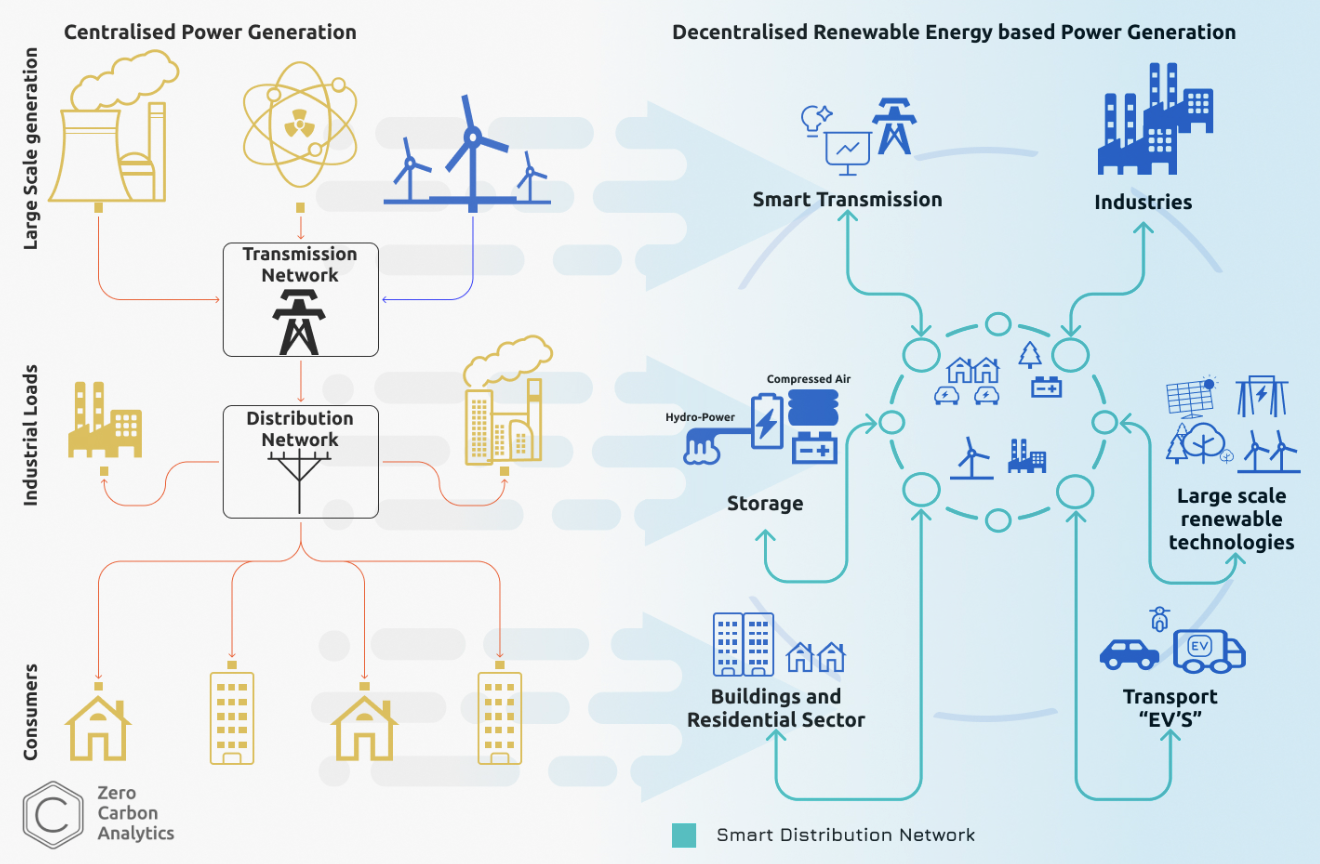How to spot greenwashing in a sustainability report: A guide to spotting false environmental claims
Greenwashing can take various forms, such as false advertising or misleading labelling. This guide shows how to spot greenwashing in…

Electricity grids are the backbone of global energy systems and are becoming increasingly important in the global effort to reduce emissions and limit global warming to 1.5°C. To achieve net-zero emissions by 2050, wind and solar will need to account for almost 80% of electricity generation, which will require a significant increase in global renewable capacity.[1]BNEF, New Energy Outlook 2022. Net-zero means emissions are reduced as close to zero as possible and any remaining emissions are reabsorbed from the atmosphere, for example by oceans and forests. Global leaders have recognised this, making a commitment at COP28 to triple global renewable energy generation capacity to at least 11,000 gigawatts (GW) by 2030.[2]This goal aligns with the International Renewable Energy Agency’s (IRENA) World Energy Transitions Outlook, which outlines a plan to close the energy transition gap to stay on track to limit … Continue reading This shift presents new opportunities, but also requires a reassessment of electricity systems and debunking myths around the unreliability of renewable-based grids.
In 2022, the amount of energy generated globally from solar and wind increased by 17.54% compared to the previous year.[3]BNEF, Capacity & Generation Data Hub, accessed February 2024. The International Energy Agency (IEA) predicts that renewables will surpass coal as the biggest source of electricity generation by 2025. By 2028, solar photovoltaic (PV) and wind energy are expected to contribute 25% of global electricity generation. Denmark is predicted to lead this shift with wind and solar accounting for 90% of its total electricity generation by 2028. The global share of renewables could be higher in reality, as forecasts for renewable generation are regularly revised upwards – influenced by evolving technologies, changing government policies and new evidence. The IEA increased its forecast for renewables growth by 76% between 2020 and 2022 amid a wave of new policies in response to Russia’s invasion of Ukraine and soaring fossil fuel prices.
Wind and solar are the cheapest, quickest to deploy and least carbon-intensive power sources available. The cost of these technologies has been declining rapidly over the past decade: between 2010 and 2020 the cost of wind power fell by 55% and the cost of solar decreased by 85%. The cost of batteries used to store electricity from variable renewable energy (VRE), such as solar and wind, also fell by over 85% in the same period. Rising manufacturing capacity is likely to drive down production costs for wind and solar technologies further in coming years.
However, one of the main obstacles to a faster renewables rollout is insufficient investment in grid infrastructure. According to the IEA, 3,000 GW of renewable power projects are waiting to be connected to grids across the US, Spain, Brazil, Italy, Japan, the UK, Germany, Australia, Mexico, Chile, India and Colombia. Around 1,500 GW of this total are wind and solar projects that are at an advanced stage of development with a connection agreement in place or under active review, but are not yet operational. That is equivalent to five times the amount of total solar PV and wind capacity added in 2022.
Decarbonised electricity systems require grids that are able to utilise distributed resources and can accommodate the rise of electric vehicles (EVs) and electric heating and cooling systems. Figure 1 illustrates the difference between a centralised power system that is based largely on fossil fuels and a distributed power system based on renewable energy. Although some centralised power systems have renewable elements, a fully renewable-based electricity grid will be decentralised and will need to integrate distributed resources to provide a stable supply.

Myths surrounding the unreliability of renewable energy in the electricity grid largely come from outdated perspectives and misconceptions about the capabilities of wind and solar power. It’s crucial to reconsider these myths in light of the latest real-world data and scientific evidence, especially as the cost of wind and solar continues to decrease and the share of electricity generated by renewables rises.
One common misconception is that wind and solar generation require backup fossil fuel capacity in electricity grids due to unreliability. However, recent studies have shown that achieving between 70% and 100% of wind and solar energy in the grid is possible and economically feasible (Table 1). These pathways for zero-carbon grids show that wind and solar generation do not require backup fossil fuel capacity for reliable electricity supply.
Additionally, several countries are making progress towards achieving fully renewable-based grids. Portugal hit a milestone in April 2023 by generating more than 50% of its electricity from wind and solar sources that month, according to data from energy think tank Ember. This was driven by the deployment of solar capacity, which reached an all-time high in April. The increase in solar counteracted low hydro generation amid a drought and resulted in reduced fossil fuel generation of 24%. Overall in 2023, wind accounted for 25% of Portugal’s energy consumption, while solar made up 7% – which involved a 43% year-on-year increase in solar PV generation.
Spain also crossed a historic threshold in its energy sector in 2023, with renewable sources accounting for 50.4% of its electricity generation and totalling nearly 135,000 gigawatt hours. Wind and solar PV sources contributed a combined 38%, with hydro largely supplying the rest of the renewable share. The falling cost of wind and solar played a significant role in their expanded role in both Spain and Portugal’s electricity grids. In the second half of 2023, Spain and Portugal had some of the lowest costs for new build technology for solar PV globally.
All electricity supply varies and all types of power plants experience downtime for maintenance, refuelling or unexpected safety reasons. Hydroelectric dams’ output is affected by seasonal variations in water availability and drought. Nuclear power plants, which provided 63% of electricity in France in 2022, were subject to outages lasting between four and 365 days amid corrosion probes and repairs. French utility EDF shut down its nuclear reactors for a total of 8,515 days in 2022. Wind and solar benefit from being coupled. Integrating these two sources into electricity grids ensures a steady energy supply and minimises the chance of power shortages during adverse weather such as storms.
| Argument | Scope | Key findings |
|---|---|---|
| 100% renewable grids are feasible and stable | A study led by Mark Jacobson, analyses 2050–2051 grid stability across US states after energy used for electricity, transport, buildings and industry transitions to 100% renewable electricity, powered by wind, solar and water (WWS) sources and heat, plus storage and responsive demand. | Whereas transitioning to renewables more than doubles electricity use, it reduces total end-use energy demand by ∼57% compared to business-as-usual (BAU), contributing to on average 63% lower annual private energy costs and 86% lower social costs.[4]Social costs refer to the combined expenses associated with energy transition, encompassing private, health, and climate-related costs. These include direct expenditure, healthcare expenditures due … Continue reading The study finds that US states and regions can maintain grid stability and avoid blackouts, despite variable and extreme weather, while providing 100% of their all-purpose energy with WWS. |
| Countries do not have to rely on fossil fuels to stabilise the grid and back up variable wind and solar power | A report by the UK Climate Change Committee (CCC) demonstrates what a reliable, resilient and decarbonised electricity supply system could look like for the UK in 2035. The CCC sees cheap – but variable – wind and solar meeting 70% of demand. While nuclear and biomass might meet another 20%, they are “relatively inflexible”. The final 10% will come from low-carbon backup generation alongside other forms of flexibility (including responsive demand such as smart electric vehicle charging, interconnection, storage and low-carbon back-up plants).[5]In the CCC report, hydrogen and gas CCS generation are classified together as low-carbon dispatchable generation due to uncertainty over their respective roles in the future energy system. The CCS … Continue reading | A reliable, resilient and decarbonised electricity system can be delivered by 2035. However, it requires strategic planning and policy changes. Transforming the electricity system would also create new employment opportunities in the solar and wind sectors. |
| Through smart energy principles, decarbonising societies is feasible and realistic | A study led by Henrik Lund models a fully decarbonised Danish society by 2045, based on smart energy systems. It includes sector coupling, district heating using zero-carbon resources, biomass at a sustainable level, as well as the rapid expansion of solar PV, wind and wave power. | A green transition of the Danish economy and society is doable, economically responsible and realistic by 2045. Compared to a BAU scenario, a transition could lead to increased employment and economic growth. |
| Storage can significantly reduce the costs of a 100% renewable electricity system | A study led by Elona Rey-Costa explores the feasibility and economic viability of transitioning Australia’s National Electricity Market (NEM) to a 100% renewable electricity system. It examines various scenarios involving oversizing of solar PV and wind power capacities, as well as scenarios with and without battery storage, to meet electricity demand.[6]Oversizing is the deliberate oversupply of solar and wind capacity to ensure that sufficient energy is always available. | The scenario with battery storage offers the lowest cost for a 100% renewable energy system. The inclusion of battery storage significantly reduces average production costs and increases the system’s economic viability. The research suggests that surplus renewable energy could power energy-intensive industries and decarbonise difficult sectors cost-effectively. |
Another common misconception is that too much wind and solar will overburden the grid. However, excess renewable power can be managed and used in a variety of ways. Denmark, a leading producer of wind power, effectively manages its excess wind and solar energy by employing storage solutions, heat pumps and flexible pricing mechanisms. Additionally, Denmark exports electricity during periods of strong wind. The Scandinavian country has six subsea connections, also known as cross-border interconnectors, with other countries and three more are planned. Denmark acts as a gateway for green electricity, which is exported from Sweden or Norway to Germany. It prioritises the integration of electricity in transport, reducing the amount of wasteful curtailment.[7]Curtailment is when the output from an electricity generator is reduced because the networks are not able to accommodate the output, or because the electricity systems’ supply and demand has to … Continue reading
Denmark is also expanding its renewable energy capacity, primarily offshore wind, with plans for an additional 9 GW of power by implementing a dynamic line rating (DLR). DLR is a system that adjusts transmission capacity based on real-time weather conditions, which can potentially increase transmission capacity by up to 30%.[8]Transmission capacity is the maximum amount of electricity that can be reliably carried through transmission lines. This system dynamically regulates the amount of power that flows through overhead lines.
Cross-border interconnectors support more efficient and widespread use of renewable energy by allowing electricity to be generated in areas with high renewable energy potential and transported to areas with high demand. This is especially valuable in areas that lack natural renewable resources or sufficient land for energy infrastructure development. Research conducted by Transition Zero highlights the importance of building interconnectors between countries. Ten cables, including connections between Europe and North Africa and an East-to-West connection in Asia, could potentially save the global economy almost USD 3 trillion in the transition to net zero, compared to achieving net-zero by 2040 without these cables. Many countries could become net exporters of clean electricity and benefit from new export revenues – particularly in the Middle East and North Africa, where countries could become energy exporters or hubs to Asia, Europe and the rest of Africa.
Research led by Professor Henrik Lund underscores the importance of taking a holistic approach and not considering the electricity sector in isolation when addressing challenges related to renewable energy integration. Lund argues that the fluctuating power from renewable sources in the electricity grid, managed through smart grids, should be viewed as a part of a smart energy system. Smart grids, primarily applied within the electricity sector, connect flexible demand and intermittent renewables, and Lund advocates for a cross-sector integration approach. This involves incorporating not only electricity grids but also heating, cooling and industry. Lund proposes that smart energy systems, encompassing electricity, thermal and gas grids along with storage technologies, can identify synergies across various sectors. For instance, excess heat from industry and electricity production can efficiently heat buildings through district heating, and electricity for heating can be used for balancing power and electric grid services. Embracing a cross-sector approach to energy systems also unlocks additional benefits such as significant reductions in costs.
To incorporate more renewables into the energy system, greater flexibility is needed. This means adapting to the variable nature of renewable sources to manage uncertainty and changes in electricity generation due to weather conditions. There are four key aspects integral to achieving flexibility in energy systems: supply-side flexibility, storage solutions, demand-side flexibility, and digitalisation through smart grids:
Several countries are leading the transition towards renewable grids. In 2022, Denmark had one of the highest shares of renewable energy in its overall electricity generation. Solar and wind power contributed 56.67% of the country’s total electricity generation and total renewables accounted for 77.24%. Recognising growing demand for electricity in coming years, Denmark has proposed to drastically increase its production of wind and solar energy by 2030, aiming to provide green energy to 11 million households. To facilitate this plan, the government is encouraging the construction of energy parks and offering compensation to citizens and local communities living near wind turbine and solar cell installations.[10]An energy park consists of one or more areas in the same geographical area and has an annual electricity production equivalent to at least six onshore wind turbines.
Namibia, with 10 hours of sunshine per day on average, is swiftly integrating solar into its energy mix. In 2022, Namibia sourced over 37% of its total electricity generation from solar PV – a 36% increase from 2021.[11]BNEF, Capacity and Generation Data Hub. The country wants to connect 80% of its population to renewables by 2025, focusing on both grid-connected and off-grid projects. According to Climatescope, there is an estimated 20 MW of off-grid capacity in Namibia’s capital Windhoek. Namibia aims to reduce its dependency on electricity imports from neighbouring countries such as South Africa, Zambia and Zimbabwe, while also exporting electricity.
Uruguay has one of the highest shares of total population with access to electricity in Latin America and the Caribbean. It also comes fourth in the world in the level of electricity generation from wind and solar sources, with wind accounting for 32% and solar making up 3% of total generation in 2022. The country tends to generate a surplus of renewable energy, allowing it to export electricity to Argentina and Brazil, stark progress from 2005 when solar or wind were not part of the energy mix. The basis for the transformation of Uruguay’s energy mix was the availability of natural resources, a long-term regulatory framework and investments in energy infrastructure – totalling around 3% of its gross domestic product annually.
The electrification of transport, buildings and industries in Europe is expected to triple peak power demand by 2050. However, the European electricity grid is experiencing long queues for the connection of new projects due to underinvestment in infrastructure and inadequate regulation of the electricity market. To address these challenges, investment is required for grid upgrades, flexibility, digitalisation and expansion of the grid’s length to almost 10,000 km (up from around 7,000 km in 2022), according to BNEF.[12]BNEF, Europe Needs Clean Power and Grid Funding Balance, 2023.

In 2022, Europe invested USD 91 billion in non-fossil fuel power generation capacity, while investment in power grids amounted to around USD 57 billion. The current ratio of grid to clean power investment works out to around 0.6. According to research by BNEF, an average of USD 0.90 of grid investment is needed for every dollar spent on clean power over 2022-2040 to reach net zero by 2050.
References
| ↑1 | BNEF, New Energy Outlook 2022. Net-zero means emissions are reduced as close to zero as possible and any remaining emissions are reabsorbed from the atmosphere, for example by oceans and forests. |
|---|---|
| ↑2 | This goal aligns with the International Renewable Energy Agency’s (IRENA) World Energy Transitions Outlook, which outlines a plan to close the energy transition gap to stay on track to limit global warming to 1.5°C. |
| ↑3 | BNEF, Capacity & Generation Data Hub, accessed February 2024. |
| ↑4 | Social costs refer to the combined expenses associated with energy transition, encompassing private, health, and climate-related costs. These include direct expenditure, healthcare expenditures due to pollution-related illnesses, and economic impacts stemming from climate change. |
| ↑5 | In the CCC report, hydrogen and gas CCS generation are classified together as low-carbon dispatchable generation due to uncertainty over their respective roles in the future energy system. The CCS 2035 models suggest that 30 terawatt hours (TWh), of hydrogen generation (with a range of 15-45 TWh) and 10 TWh of gas CCS (with a range of 0-20 TWh) can make up the remaining 40 TWh of generation in the 2035 scenario. If hydrogen can fill the remaining gap, there’s no need for reliance on fossil fuels. |
| ↑6 | Oversizing is the deliberate oversupply of solar and wind capacity to ensure that sufficient energy is always available. |
| ↑7 | Curtailment is when the output from an electricity generator is reduced because the networks are not able to accommodate the output, or because the electricity systems’ supply and demand has to be kept in balance. In some countries, such as the UK, wind and solar generators are often curtailed because distribution networks have not been upgraded to cope with output at certain times. |
| ↑8 | Transmission capacity is the maximum amount of electricity that can be reliably carried through transmission lines. |
| ↑9 | BNEF, Energy Transition Investment data 2023 |
| ↑10 | An energy park consists of one or more areas in the same geographical area and has an annual electricity production equivalent to at least six onshore wind turbines. |
| ↑11 | BNEF, Capacity and Generation Data Hub. |
| ↑12 | BNEF, Europe Needs Clean Power and Grid Funding Balance, 2023. |

Greenwashing can take various forms, such as false advertising or misleading labelling. This guide shows how to spot greenwashing in…

Developing the sector - and addressing its challenges - could help drive sustainable economic development and the energy transition in…